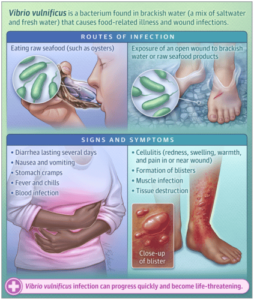However, in terms of overall weirdness, there’s one thing that easily tops the cake for me: going to the beach.
Yup, the most bizarre consequence of getting diagnosed with hereditary hemochromatosis is how it’s transformed my relationship with the beach. Where I live, most ocean beaches aren’t made of soft, pearly white sand. Sure, sand is there, but it’s littered with crusty barnacles, cracked shells from mussels, oysters, and crabs, and jagged rocks and pebbles.
In the past, I didn’t think twice about it – it was always a place for paddleboarding, kayaking, walking my dogs, and watching the sunset. Why care about a few dried up crustaceans? While I still love those activities, I’m more aware of my surroundings now.
What’s changed? The beach, along with the ocean and the fish that live in it, now poses a strange but deadly threat – a threat that has made me become extra cautious.
And it’s all because of a flesh-eating bacteria called Vibrio vulnificus.

vibrio vulnificus and hemochromatosis
Vibrio vulnificus sounds like a funny word out of a Dr. Seuss book, but in reality it’s a major health hazard that can place you in a life-or-death situation.
This flesh-eating bacteria lives in seawater and brackish water. In the US, it’s found in the waters of both the east and west coasts, as well as the Gulf of Mexico. If often contaminates shellfish, like oysters, mussels, crabs, and clams. We can be exposed to Vibrio vulnificus by eating it or touching it with an open cut or wound.
If it enters the bloodstream, it causes a dangerous infection with a 50% mortality rate in people with iron overload disease.
Vibrio vulnificus is killed by normal human blood but grows rapidly in blood from patients with hemochromatosis.
The Canadian Hemochromatosis Society advises, “Raw shellfish, especially oysters, carry a bacteria called Vibrio vulnificus that can be deadly to people with iron overload because it thrives on iron. Even handling raw shellfish can be dangerous if there are any breaks in the skin.”
The Iron Disorders Institute cautions:
People with high iron should always take care not to eat raw shellfish or walk barefoot on a beach where they might step on an infected shell.
Why is the Vibrio Vulnificus bacteria more dangerous for people with hereditary hemochromatosis? What makes us high-risk?
HIGH IRON LEVELS: people with hereditary hemochromatosis tend to have higher amounts of iron circulating in their blood at any given time, creating an environment where Vibrio vulnificus thrives.
LOW HEPCIDIN LEVELS: people with hereditary hemochromatosis don’t make enough of the hormone hepcidin, which is vital for fighting off Vibrio vulnificus.
LIVER PROBLEMS AND OTHER HEALTH ISSUES: people with hereditary hemochromatosis may experience more liver problems and other secondary health issues that create a higher susceptibility to Vibrio vulnificus infection.

high iron levels
Having hemochromatosis means you typically have compromised defenses when fighting off organisms. You’re a great host for certain bacteria because they proliferate in iron-rich environments.
While different types of bacteria all use iron to their advantage in their own individual ways, Vibrio vulnificus grows particularly well in blood with elevated ferritin as well as blood with elevated transferrin saturation.
You may be thinking, “but I get regular phlebotomies, doesn’t that mean my iron levels – including ferritin and transferrin saturation – are normal?”
Let’s look into that…
FERRITIN
There are several ways to measure your body’s iron levels, including ferritin, transferrin saturation, and serum iron.
Getting a phlebotomy (or losing blood in any way, shape, or form) is best at reducing ferritin levels.
Now, even if you stick to a phlebotomy schedule, ferritin may rise to higher than average levels in between phlebotomies. But overall, phlebotomies are a super effective method to get those ferritin levels DOWN, and this is helpful for fending off Vibrio vulnificus.
Phlebotomies decrease ferritin. This helps your odds against Vibrio vulnificus.
What about transferrin saturation?
TRANSFERRIN SATURATION
Here’s where phlebotomies don’t do a great job, and why some people – even those who are religious about their phlebotomy schedule – may be more susceptible to Vibrio vulnificus and other bacterial infections than they want to be. If your experience with hereditary hemochromatosis has been anything like mine, then you know that despite ferritin levels being normal, it’s still quite possible to have high transferrin saturation. This is sometimes known as iron avidity in the hereditary hemochromatosis world.
Here’s what researchers have found:
Even if patients with hemochromatosis maintain low serum levels of ferritin, they still have an increased risk of general and joint symptoms, which reduce quality of life. This could be related to persistently increased transferrin saturation.
Genes play a role. The Iron Disorders Institute points out a phenomenon in those who are C282Y homozygotes (like me), saying that, for these individuals, transferrin saturation “can remain elevated while the serum ferritin is normal or low.”
Treatment also matters. Transferrin saturation can shoot upwards and remain high if you’re over-treated with phlebotomies. When this happens, the body’s internal monitoring mechanisms decide that too much iron has been removed from the blood loss. An over-bled body kicks into its natural defenses and stockpiles all the iron it can by skyrocketing transferrin saturation.
This is why maintaining healthy iron levels for both ferritin and transferrin saturation can be trickier than it seems. Your levels can change depending on your treatment plan and how your individual body absorbs and manages iron. The more you check your iron levels, the more you’ll understand about your own tendencies with iron avidity. It’s important to work with your doctor to regularly monitor your levels for all measures of iron when you have hemochromatosis.
MAIN TAKEAWAY
Vibrio vulnificus more easily infects those who have high iron levels in the form of elevated ferritin and/or elevated transferrin saturation. Even with a regular phlebotomy schedule, some of your iron markers may remain high, making you more susceptible.

low hepcidin levels
Hepcidin is the most important hormone that no one’s talking about. If you have hereditary hemochromatosis, you have too much iron because you don’t make enough hepcidin. That’s why we should all be way more interested in hepcidin.
Hepcidin’s main role is to regulate iron absorption, however it has another big job – it fights off Vibrio vulnificus and other bacteria. Researchers have discovered that “hepcidin is required for resistance to a Vibrio vulnificus infection.”
In science-speak, hepcidin displays “bactericidal activity” when pitted against Vibrio vulnificus. Because you’re hepcidin-deficient, you’re missing out on hepcidin’s abilities to help you wipe out this bacteria. This is another reason why you’re “predisposed” to Vibrio vulnificus infection.
Here’s a passage from an interesting article about the relationship between hereditary hemochromatois, hepcidin, and Vibrio vulnificus:
“Now, researchers at UCLA have figured out why those with iron overload disease are so vulnerable. People with the common genetic iron overload disease called hereditary hemochromatosis have a deficiency of the iron-regulating hormone hepcidin and thus develop excess iron in their blood and tissue, providing prime growth conditions for Vibrio vulnificus. The study also found that minihepcidin, a medicinal form of the hormone hepcidin that lowers iron levels in blood, could cure the infection by restricting bacterial growth.”
MAIN TAKEAWAY
Because hereditary hemochromatosis makes you hepcidin-deficient, you don’t get hepcidin’s antibacterial benefits, predisposing you to Vibrio vulnificus infection.

liver problems and other health issues
Getting a hereditary hemochromatosis diagnosis often comes with a slew of other health issues caused by the toxic effects of having too much iron in your body for too long. If your hemochromatosis went undiagnosed for years, that means your body has gone through a thrashing. Your organs have been taxed from years of iron overload, and this is especially true for one organ in particular: your liver.
How well your liver functions is indicative of your immune response to Vibrio vulnificus. A healthy liver scavenges pathogens and helps to rid the body of bad bacteria. An unhealthy liver is already overwhelmed with toxins and is incompetent at eliminating germs. So if you’ve got any serious liver issues, this may be another reason to be cautious around Vibrio vulnificus.
Diabetes, another disease that can be caused by caused by hemochromatosis, also makes you more at risk of contracting Vibrio vulnificus.
There are a few other risk factors as well. Cleveland Clinic says the following conditions make anyone more vulnerable to Vibrio vulnificus infection:
- Liver diseases, including cirrhosis.
- Hemochromatosis.
- Chronic kidney (renal) failure.
- Diabetes.
- Conditions that weaken or alter your immune system.
MAIN TAKEAWAY
Liver disease, diabetes, as well as a handful of other secondary health issues that can be caused by hemochromatosis may hurt your defenses against Vibrio vulnificus even more.

symptoms and treatment of vibrio vulnificus infection
How do you know if you’ve contracted Vibrio vulnificus? What are the signs?
Symptoms can be different depending on how the bacteria infiltrates your immune system. Here’s what the CDC says to watch out for:
Symptoms if you’ve ingested the bacteria (for example, by eating raw or even lightly cooked seafood): watery diarrhea, stomach cramping, nausea, vomiting, fever.
Symptoms if the bacteria has entered through your skin (for example, with an exposed cut or wound): redness, pain, swelling, warmth, discoloration, a leaky discharge, and the wound may start to spread.
Symptoms once the bacteria gets into the bloodstream: fever, chills, dangerously low blood pressure, and blistering lesions.
Click on this infographic to view the symptoms of Vibrio vulnificus:

If you catch it in time, Vibrio vulnificus infection can be treated with antibiotics. If left untreated, Vibrio vulnificus may cause sepsis (blood poisoning from bacteria) and severe wound infections. Amputations of legs or arms are sometimes required to remove dead tissue. The mortality rate is 50% in people with iron overload disease.

how to enjoy the beach worry-free
Vibrio vulnificus thrives during warmer months when ocean temperatures are at their peak. Unfortunately, these summer months are also when we want to be at the beach!
We have to be careful coming into any contact at all with Vibrio vulnificus. That’s why walking barefoot or in loose sandals on the beach can be unsafe. If a shell cuts into your skin and the bacteria makes its way into your bloodstream, you could be putting yourself at risk for this potentially fatal illness.
Before my diagnosis with hereditary hemochromatosis, I didn’t give a moment’s thought to any possible dangers of walking barefoot or wearing flip flops at the beach. I never even considered special “water shoes” or “beach shoes.” I’m much more mindful now. I always bring closed-toed shoes with me to protect my feet, whether I’m paddle boarding, boating, or just splashing around on a walk with my dogs.
If you’re looking for a way to enjoy the beach, start with your shoes. Simply by wearing a good pair of closed-toed shoes, you’ll avoid stepping on broken shells and other flotsam and jetsam from the ocean that could potentially infect your skin. You can participate in the beach activities you love (like picnicking, swimming, kayaking, water skiing…) without fear of ending up sick or in the hospital.
And luckily, water shoes are way more stylish than they used to be – they’re actually kinda cute! So you might just be setting a new trend. Here are a few options worth checking out:
QUICK DRYING WATER SHOES:
DLGPA Lightweight Quick Drying Water Shoes
SLIP ON WATER SHOES:
Aleader Mesh Slip on Water Shoes
VELCRO WATER SHOES:

water and wounds don’t mix
Even with your ultra-hip new beach shoes on, remember that Vibrio vulnificus originates from the water. “Water and wounds do not mix” when it comes to Vibrio vulnificus. The whole point of wearing shoes is to protect your skin from getting scratched, as you need to prevent this bacteria from entering your bloodstream.
The same principle applies to the rest of your body!
If you’ve got any sort of cut on any area of your skin, make sure to stay out of the water completely. People can get infected through “cuts or other lesions in the skin that come into contact with seawater.”
Sadly, it seems that Vibrio vulnificus may be becoming more prolific in our waters, so be diligent about keeping your scrapes dry.
diet matters
Evidence shows that people with hereditary hemochromatosis are more likely to develop Vibrio vulnificus infection than others when we eat raw or undercooked seafood. That’s why we’re considered a high-risk population.
Experts like those at the Mayo Clinic say anyone with hemochromatosis needs to stay away from eating raw fish. Shellfish, particularly oysters, pose the biggest threat.
Other seafood with a track record of carrying Vibrio vulnificus includes “fish, shrimp, crab, or lobsters” as well as “clams, mussels, and scallops.”
While I try to stick to a plant-focused diet as much as possible, if you choose to eat seafood then you’ll want to be wary of touching, handling, and eating raw or undercooked seafood. This includes shells, juices, and anything else (including packaging) that hasn’t been properly heated or sanitized.
stayin’ alive
Knowing the inherent risk and mortality rate for those with hereditary hemochromatosis, it’s essential to minimize the chances of a Vibrio vulnificus infection.
Do these THREE things to keep Vibrio vulnificus out of your life.

- Don’t eat or handle raw seafood, especially raw shellfish which are particularly prone to being contaminated with this bacteria.
- Wear closed-toed water shoes (like this pair) at the beach.
- If you have any cuts on your skin, keep them out of ocean water and brackish water during warmer months.

The views expressed in this post are for informational purposes only. This post is not, nor is it intended to be, a substitute for professional, medical, or nutritional advice, diagnosis, or treatment, and should never be relied upon for professional, medical or nutritional advice, diagnosis, or treatment.
No content on talorae.com, including but not limited to pictures, graphics, videos, and text, may be republished or distributed, for financial gain or not, without my written permission.
As an Amazon Associate I earn from qualifying purchases. The above content may contain affiliate links, meaning I do get a commission when you make a purchase through those links. There is no additional cost to you. Please read my disclaimer for more info.
